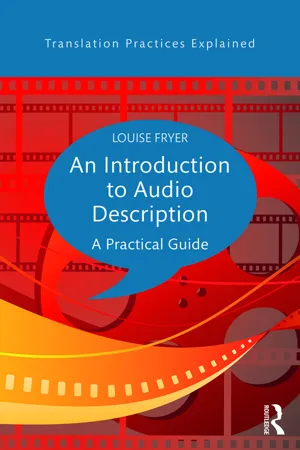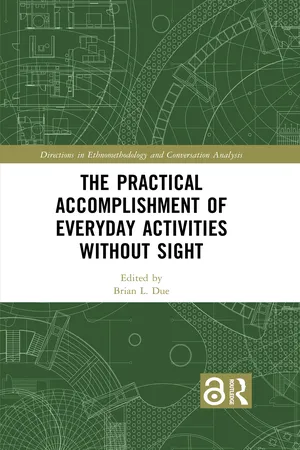Languages & Linguistics
Auditory Description
Auditory description is a technique used to provide a verbal description of visual content, such as films, television shows, and live performances, for individuals who are blind or visually impaired. It involves describing the visual elements of a scene, including the setting, characters, and actions, in a way that allows the listener to form a mental image of what is happening.
Written by Perlego with AI-assistance
Related key terms
Related key terms
1 of 4
Related key terms
1 of 3
4 Key excerpts on "Auditory Description"
- eBook - ePub
An Introduction to Audio Description
A practical guide
- Louise Fryer(Author)
- 2016(Publication Date)
- Routledge(Publisher)
3 Putting the audio into audio description DOI: 10.4324/9781315707228-33.1 Introduction
Evidently two main information streams combine to convey the information in AV media: the visual (essentially implicit) and the auditory (generally, but not always, explicit). While visual information is at the core of the source material for the describer it is super-abundant, meaning that often it is the auditory information that narrows down what should be described. This chapter dissects the auditory information stream and analyses how it influences the editorial choices of the describer.3.2 The visual information stream
The role of a describer is to convey or summarise the visual information. The way in which sighted people perceive such information has already been discussed. One glance is usually enough to tell us: who is in a scene, where they are located, what they are doing and the way in which they are doing it (how). Vision overrides information pick-up from other modalities such as hearing. When presented with bimodal (auditory and visual) stimuli, sighted people respond more quickly to the visual component than to the auditory one (Koppen and Spence, 2007 ). However, each influences the other. Michel Chion et al. (1994) refer to the audio-visual contract. They point out that we never see the same thing when we also hear; we do not hear the same thing when we also see.The art of ventriloquism relies on prioritising the visual stimulus of the dummy’s moving mouth over the auditory stimulus (the words coming from the operator), such that the dummy appears to be speaking. We experience a similar effect in the cinema, attributing words to the characters on the screen in front of us, even though the voices are relayed via speakers placed around the side and back walls of the auditorium (Murray et al., 2005 ).Visual information is generally considered to be continuous, with everything in our field of vision instantly (and repeatedly) accessible. Auditory information, by contrast, is linear. It is generally thought of as an intermittent sequence of sounds and ‘gaps’ where there is no sound. This is not necessarily true – for either sense. Our eyes constantly dart from one point of fixation to the next in a series of jumps or saccades, with our brains filling in the missing detail and ensuring that an image persists while new information is added, so that the picture is fleshed out. We learn to watch film so that, rather than a series of static shots, we perceive it as a moving image, untroubled by changing points of view and perspective. - Brian L. Due(Author)
- 2023(Publication Date)
- Routledge(Publisher)
4 Guided by the blindDiscovering the competences of visually impaired co-authors in the practice of collaborative audio-descriptionMaija Hirvonen1DOI: 10.4324/9781003156819-4Introduction
This chapter studies the interaction between visually impaired and sighted people (co-authors2 ) in the context of teamwork in audio-description. Audio-description is a professional translation field and requires specific expertise. By analyzing work procedures in which the teams carry out certain tasks, I aim to describe how visual impairment is used as a resource for accomplishing these tasks, and how the visually impaired co-author’s competences are both independent of and dependent on their visual impairment.Audio-description is an access service primarily targeted at visually disabled people to support their participation in audiovisual and visual culture and communication. It often takes the form of audible narration added to films, television programmes, theatrical plays, and the like. Audio-description is intermodal translation: visual information or representations are described with words and delivered in speech to be perceived via hearing. Audio-descriptions are produced to various extents in different countries and languages (see, e.g. Taylor & Perego, 2022 ). Some countries have developed a professional practice in which audio-descriptions are prepared in face-to-face interaction among teams consisting of sighted and blind experts. Visually impaired professionals are employed to safeguard the quality of the translation by taking the user perspective into account (on visually impaired-sighted teamwork in AD, see Benecke, 2014 ; Schruhl, 2021 ; on collaborative translation, O’Brien, 2011- eBook - ePub
Representing Translation
The Representation of Translation and Translators in Contemporary Media
- Dror Abend-David, Dror Abend-David(Authors)
- 2019(Publication Date)
- Bloomsbury Academic(Publisher)
Audio Description for All? Enhancing the Experience of Sighted Viewers through Visual Media Access Services Iwona Mazur1. Introduction
Audio description (AD) has been created with visually impaired persons (VIPs) in mind. It gives them access to the visual semiotic codes that would otherwise remain inaccessible to them. However, AD can also benefit and be enjoyed by sighted persons. As noted by Lou Giansante (n.d.), a writer and producer of museum audio tours meant for both sighted and visually impaired visitors, “[s]ighted people have come to expect descriptions of what their eyes can see easily,” as such tours “can focus attention, making for a richer experience.” In addition to being a guiding tool, AD can potentially have a number of other cognitive, linguistic, experiential (aesthetic), and social benefits, enriching the experience of persons with no visual impairment. The benefits will be discussed in the chapter below, preceded by a brief definition of AD and its primary recipients, and followed by the Universal Design paradigm applied to AD.2. Audio description and its primary recipients
Audio description, sometimes referred to as video description or described video (Piety 2004: 453), is a type of transfer involving verbal representation of visual content of a film, a TV show, a theater play, an opera performance, a museum exhibition, a sports event, or possibly any other event that includes visuals, such as a rodeo or a funeral (Snyder 2007). Depending on the object of description, what is usually described are the spatio-temporal setting, characters, actions (in a film, a theater play or an opera performance), works of art such as paintings, sculptures, installations at an exhibition, or the performance of players or athletes at a sports event. AD can be live (theater, opera, sports event) or recorded (film, TV, museum), static (museum) or dynamic (film, theater, opera, sports event). In the case of dynamic AD, it has the form of an additional narration track that is inserted between dialogs and/or other meaningful sounds. - eBook - ePub
- Maeve Olohan(Author)
- 2014(Publication Date)
- Routledge(Publisher)
et al. (1998:357), where the target text is subordinate to other requirements, in this case the image. More specifically, it may be seen as a type of intersemiotic constrained translation, since the descriptions, when not accompanied by the document in which the images are included, do not make sense by themselves.Documentaries and multimedia documents are increasingly used to disseminate specialized knowledge. They are addressed to, and accessed by, different audiences: experts, students and general audiences. Today, the multiplicity of multimedia resources created for such diverse audiences can help to bridge the gap between scientific communities and the rest of the population. However, while the use of multimedia enhances knowledge representation, knowledge acquisition and knowledge transfer, it is also true that it poses issues of accessibility, since users must possess the full range of sensory abilities in order to take full advantage of such resources. Modes of accessibility to multimedia products must therefore be carefully examined, the most common of these being subtitling for the deaf and hard of hearing (SDHH) and audio description (AD) for the blind and visually impaired, fields in which scholars of translation began to develop an interest at the turn of the century (Orero 2005, 2007).This paper will focus on audio description for the blind and visually impaired and will limit itself to non-fictional scientific material published in multimedia formats. The largely uncharted territory of dynamic images in non-fictional scientific documents (documentaries and multimedia presentations) will be addressed from two perspectives: the examination of current research, guidelines and usages in AD in connection with documentaries, and the exploration of alternatives to current AD practices and techniques. We start by analyzing ADUs in documentaries, in order to ascertain to what extent current audio description practices are appropriate for non-fictional scientific material, before proposing alternatives to such practices by creating ADUs of specific application to scientific talks available on the web.
Index pages curate the most relevant extracts from our library of academic textbooks. They’ve been created using an in-house natural language model (NLM), each adding context and meaning to key research topics.
Explore more topic indexes
Explore more topic indexes
1 of 6
Explore more topic indexes
1 of 4



